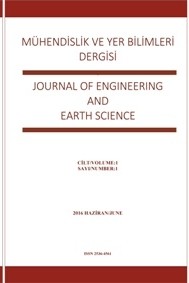Killi Karışımlarda Su İçeriği Dağılımı
Killi karışımlar genelde geçirimsiz tabaka amacı ile kullanılmaktadır. Killi karışımların en sık rastlanılanı sıkıştırılmış kum bentonit karışımları olmakla beraber, son zamanlarda sıkıştırılmış zeolit bentonit karışımları da alternatif olarak önerilmiştir. Zeolit ve kum arasındaki en temel fark kum danelerinin geçirimsiz zeolit danelerinin ise geçirimli mikro boşluklu yapıya sahip olmalarıdır. Buna ek olarak zeolit, bünyesinde, kumun aksine, bir miktar su da tutabilmektedir. Bu sebeple, bentonitin zeolit ile karıştırılması sonucunda davranışının kum ile karıştırıldığındakinden farklı olması beklenmektedir. Zeolit ve kum arasındaki bu temel farklılık maalesef araştırmacılar tarafından çoğu kez es geçilmiş ve değerlendirmelerde zeolitin su içeriği, kumda olduğu gibi sıfıra eşit olarak kabul edilmiştir. Bu çalışmada, zeolit bentonit ve kum bentonit karışımlarındaki elemanların su içeriği dağılımları incelenmiştir. Değerlendirme esnasında kumun su içeriği sıfır olarak kabul edilmiştir. Farklı dane çaplarındaki zeolit örneklerinin suya doygun haldeki su içerikleri %28 olarak bulunmuş olup bu durum, zeolitin bentonitle bir karışım halinde iken su içeriği konusunda bu iki zeminin bir yarışa gireceklerini düşündürmektedir. Deney sonuçları, zeolitin su içeriğinin karışımın optimum su içeriğine kadar artış gösterdiğini ve bir maksimum değere ulaştıktan sonra da hızlıca azaldığını göstermiştir. Bentonit su içeriği ise zeolit bentonit ve kum bentonit karışımlarının su içerikleri optimumda ve optimumlarının kuru tarafında neredeyse aynı iken; optimumlarının ıslak tarafında ise zeolit bentonit karışımlarındaki bentonit su içerikleri, kum bentonit karışımlarındakinden daha yüksek bulunmuştur.
Anahtar Kelimeler:
Killi karışımlar, zeolit, bentonit, su içeriği
Water Content Distribution of Binary Soil Mixtures
Binary soil mixtures are mostly used for liner materials. The most common binary mixture is compacted sand bentonite mixture; lately compacted zeolite bentonite mixture is also proposed. The major difference between sand and zeolite is that, sand is an impervious grain where zeolite is a pervious, microporous grain. Additionally, zeolite holds water whereas sand does not. Thus, when bentonite is blended with zeolite, the mixtures is expected to behave different than it’s blended with sand. Unfortunately, this major difference is rarely of interest by researchers and zeolite water content was used to be assumed to be zero like sand. This study investigates the water content distribution of components in binary mixtures namely, zeolite bentonite mixture and sand bentonite mixture. During the tests, it is assumed that sand had no water content. The saturated state water content of zeolite for varying grain sizes was found to be 28% and zeolite and bentonite are found to be in competition to hold water. Test results showed that zeolite water content increases slightly up to the optimum water content of the mixture, reaches a maximum value and then starts to decrease rapidly. The water content of bentonite in zeolite bentonite mixture and sand bentonite mixture is found to be almost the same between the dry of optimum and optimum compaction states and when the mixtures are in wet of optimum compaction state the water content of bentonite in zeolite bentonite mixture is getting to be higher than it is in sand bentonite mixture.
Keywords:
Binary mixtures, zeolite, bentonite, water content,
___
- Alver, B. E., Sakızcı, M. and Yörükoğullari, E. (2010). Investi-gation of clinoptilolite rich natural zeolites from Turkey: a combined XRF, TG / DTG, DTA and DSC study, J Therm Anal Calorim, 100, 19–26.
- Caputo, D. and Pepe, F. (2007). Experiments and data pro-cessing of ion exchange equilibria involving Italian natural zeolites: a review, Microporous and Mesoporous Materials, 105(3), 222–231.
- Durukan, S. (2013). A study on mechanisms controlling the hydraulic conductivity of eolite-bentonite and sand-bentonite mixtures. Ph.D. Thesis, Graduate School of Natural and Ap-plied Sciences, Dokuz Eylül University, Izmir.
- Durukan S., Kayalar, A. Ş. and Başarı E. Hydraulic conductivi-ty and suction characterization of Gördes zeolite blocks. 1st International Porous and Powder Materials Symposium and Exhibiton. Proceedings; 2013 Sep 3-6; İzmir (Turkey); 2013; p.651-655.
- Hong, C. S., Shackelford, C. D., Malusis, M. A. (2016). Ad-sorptive Behavior of Zeolite-Amended Backfills for Enhanced Metals Containment, Journal of Geotechnical and Geoenvi-ronmental Engineering, 142, 7, 1–16.
- Kayabalı, K. (1997). Engineering aspects of a novel landfill material: Bentonite amended natural zeolite, Engineering Geology, 46, 105-114.
- Kayabalı, K. and Kezer, H. (1998). Testing the ability of ben-tonite amended zeolite (clinoptilolite) to remove heavy met-als from liquids waste, Environmental Geology, 34, 95-102.
- Kaya, A.and Durukan, S. (2004). Utilization of bentonite embedded zeolite as clay liner, Applied Clay Science, 25, 83-91.
- Kenney, T.C., van Veen, W.A., Swallow, M.A. and Sungalia, M.A. (1992). Hydraulic conductivity of compacted bentonite-sand mixtures, Canadian Geotechnical Journal, 29, 364-374.
- Mumpton, W.H. (1999) La roca magica: Uses of natural zeo-lites in agriculture and industry, Proc. Natl. Acad. Sci., 96, 3463–3470.
- Ören, A.H. (2007). Engineering investigation of zeolite-bentonite mixtures for landfill liners. Ph.D. Thesis, Graduate School of Natural and Applied Sciences, Dokuz Eylül Univer-sity, Izmir.
- Ören, A. H., Durukan, S. and Kayalar, A. Ş. (2014). Influence of compaction water content on the hydraulic conductivity of sand- bentonite and zeolite-bentonite mixtures, Clay Miner-als, 49, 109–121.
- Özel, U., Akdemir, A.and Ergun, O. N. (2012). Utilization of natural zeolite and perlite as landfill liners for in situ leach-ate treatment in landfills, International Journal of Environ-mental Research and Public Health, 9(5), 1581–92.
- Özkirim, İ. and Yörükoğullari, E. (2005). Characterisatıon of bet isotherm from Manisa-Gördes natural zeolite (clinoptilo-lite), Dumlupınar Üniversitesi Fen Bilimleri Enstitüsü Dergisi, (9), 65–70.
- Tuncan, A., Tuncan, M., Koyuncu, H. and Guney, Y. (2003). Use of Natural Zeolites as a Landfill Liner, Waste Manage-ment and Research, 21, 54–61.
- Turan, N. G. and Ergun, O. N. (2009). Removal of Cu (II) from leachate using natural zeolite as a landfill liner material, Journal of Hazardous Materials, 167, 696–700.
- ISSN: 2536-4561
- Başlangıç: 2016
- Yayıncı: Remzi BAŞARI
